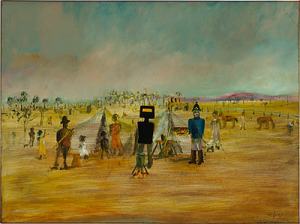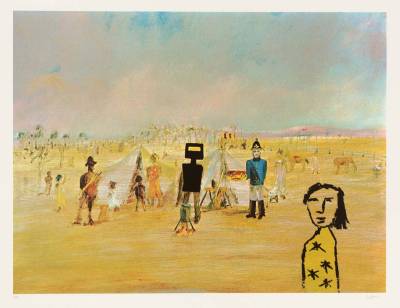Nolan’s fantasy is that Australia’s most renowned bushranger Ned Kelly enjoyed a bush picnic. His source is probably J. J. Keneally’s sympathetic biography The Complete Inner History of the Kelly Gang (1929), based on which Nolan made two series in1945-1947 and 1978-1979, which helped make an outlaw a hero (of sorts).

The Ned Kelly Series (1946). Canberra: National Gallery of Australia
For Bush Picnic (1946), Nolan suggests that the picnic is ordinary. He used a quotation from the Royal Commission report (1881) for evidence: “On one occasion, the outlaws had arranged to have a picnic some distance from Violet Town. Kelly’s friends flattered the constable and shouted freely for him. He got pretty full, and someone suggested dancing on the green. Good music was available, and Ned Kelly took the merry constable as his partner in a buck set.”
For the second series, Ned Kelly II, Nolan depicts the same scene but features an enigmatic figure that is probably intended to be Kelly on whose body are four star-shaped blotches that might be bullet holes. Perhaps the figure represents people Kelly shot and killed, or maybe it alludes to some joie de vivre that Kelly was never attainable.
Nolan identified with Kelly partly because of his life as an artist in Australian bourgeois society but more because he went AWOL from the Australian army in 1944 to avoid battle. When officially discharged for misconduct in 1945, he painted the first Ned Kelly series.
Food is of no consequence in the Ned Kelly picnics, though a boiling billycan sits over an open fire.
Featured Image: Ned Kelly II /Bush Picnic (1978-1979), Screenprint on paper. Tate Britain, London
See J.J. Keneally. The Complete Inner History of the Kelly Gang and Their Pursuers. Melbourne: Ruskin Press, 1929. Three films tell the Ned Kelly story, 1906, 1970, and 2003. None have a bush picnic.

